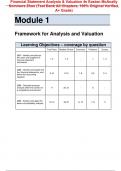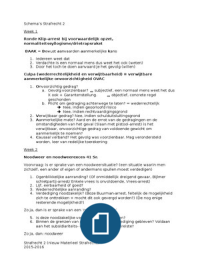Financial Statement Analysis & Valuation 4e Easton McAnally
Sommers Zhan (Test Bank All Chapters, 100% Original Verified,
A+ Grade)
Module 1
Framework for Analysis and Valuation
Learning Objectives – coverage by question
True/False Multiple Choice Exercises Problems Essays
LO1 – Identify and discuss
the users and suppliers of
1-4 1, 2 - 1 1, 2
financial statement
information.
LO2 – Identify and explain the
four financial statements, and
5-10 3-19 1-8 2-5 3, 4
define the accounting
equation.
LO3 – Describe business
analysis within the context of 11 20, 21 - 6 -
a competitive environment.
LO4 – Explain and apply the
12-14 22-27 9, 10 7, 8 5
basics of profitability analysis.
©Cambridge Business Publishers, 2015
Test Bank, Module 1 1-1
,Module 1: Framework for Analysis and Valuation
True/False
Topic: Users of Financial Statement Information
LO: 1
1. Shareholders demand financial information primarily to assess profitability and risk whereas bankers
demand information primarily to assess cash flows to repay loan interest and principal.
Answer: True
Rationale: While both shareholders and bankers are interested in all the information companies
provide, shareholders care about more about a company’s profitability and bankers care more about
solvency and creditworthiness.
Topic: Publicly Available Financial Reports
LO: 1
2. Publicly traded companies are required to provide quarterly financial reports directly to the public.
Answer: False
Rationale: Companies provide electronic versions of quarterly financial statements to the SEC, which
posts them to the Internet for the public to access them.
Topic: Users of Financial Statement Information
LO: 1
3. Publicly traded companies provide financial information primarily to satisfy the SEC and the tax
authorities (that is, the Internal Revenue Service).
Answer: False
Rationale: Demand for information extends to many users; the regulators such as the SEC and the
IRS are only one class of users.
Topic: SEC Filings
LO: 1
4. Publicly traded companies must provide to the Securities Exchange Commission annual audited
financial statements (10K reports) and quarterly audited financial statements (10Q reports).
Answer: False
Rationale: Quarterly reports do not need to be audited.
Topic: Balance Sheet
LO: 2
5. If a company reports retained earnings of $175.3 million on its balance sheet, it must also report
$175.3 million in cash.
Answer: False
Rationale: The accounting equation requires total assets to equal total liabilities plus stockholders’
equity. That does not imply, however, that liability and equity accounts relate directly to specific
assets.
©Cambridge Business Publishers, 2015
1-2 Financial Statement Analysis and Valuation, 4th Edition
,Topic: Balance Sheet
LO: 2
6. A balance sheet shows a company’s position over a period of time, whereas an income statement,
statement of stockholders’ equity, and statement of cash flows show its position at a point in time.
Answer: False
Rationale: The statement is reversed: A balance sheet shows a company’s position at a point in time,
whereas an income statement, statement of equity, and statement of cash flows show its position
over a period of time.
Topic: Accounting Equation
LO: 2
7. Assets must always equal liabilities plus equity.
Answer: True
Rationale: The accounting equation is Assets = Liabilities + Equity. This relation must always hold.
Topic: Income Statement
LO: 2
8. The income statement reports net income which is defined as the company’s profit after all expenses
and dividends have been paid.
Answer: False
Rationale: The statement contains two errors. First, net income does not include any dividends during
the period; these are a distribution of profits and not part of its calculation. Second, the income
statement is prepared on an accrual basis and thus includes expenses incurred (as opposed to paid).
Topic: Statement of Cash Flows
LO: 2
9. A statement of cash flows reports on cash flows for operating, investing and financing activities at a
point in time.
Answer: False
Rationale: A statement of cash flows reports on cash flows for operating, investing, and financing
activities over a period of time.
Topic: Statement of Stockholders’ Equity
LO: 2
10. An increase in treasury stock would be reflected in the statement of stockholders’ equity.
Answer: True
Rationale: The statement of stockholders’ equity reports on changes in the accounts that make up
stockholders’ equity. This includes contributed capital, retained earnings, and treasury stock.
©Cambridge Business Publishers, 2015
Test Bank, Module 1 1-3
, Topic: Financial Accounting and Business Analysis
LO: 3
11. Financial statements are influenced by five important forces that determine a company’s competitive
intensity: (A) industry competition, (B) buyer power, (C) supplier power, (D) product substitutes, and
(E) threat of entry.
Answer: True
Rationale: By systematically considering these five business forces, we can gain better insights from
financial statements.
Topic: Return on Assets
LO: 4
12. Return on Assets (ROA) measures the profit the company makes on each dollar of total assets it
uses.
Answer: True
Rationale: Return on Assets is a profitability metric that measures how much profit the company
made for each dollar of assets the company holds on average during the year.
Topic: Return on Assets
LO: 4
13. Return on Assets (ROA) = Net Income / Sales × Asset Turnover
Answer: True
Rationale: Return on Assets = Net Income / Average Assets. This is the disaggregation of the ROA
into its components
Topic: Asset Turnover
LO: 4
14. Consider two companies (A and B) with equal profit margins of 15%. Company A has an asset
turnover of 1.2 and Company B has an asset turnover of 1.5. If all else is equal, Company B with its
higher asset turnover, is less profitable because it is expensive to turn assets over.
Answer: False
Rationale: Asset turnover is an efficiency metric. The higher the turnover, the more efficient the
company is with its assets and thus, the more profitable. Algebraically, ROA = PM × AT. Company A
above is less profitable: 15% × 1.2 = 18% whereas Company B’s ROA is 15% × 1.5 = 22.5%.
©Cambridge Business Publishers, 2015
1-4 Financial Statement Analysis and Valuation, 4th Edition





